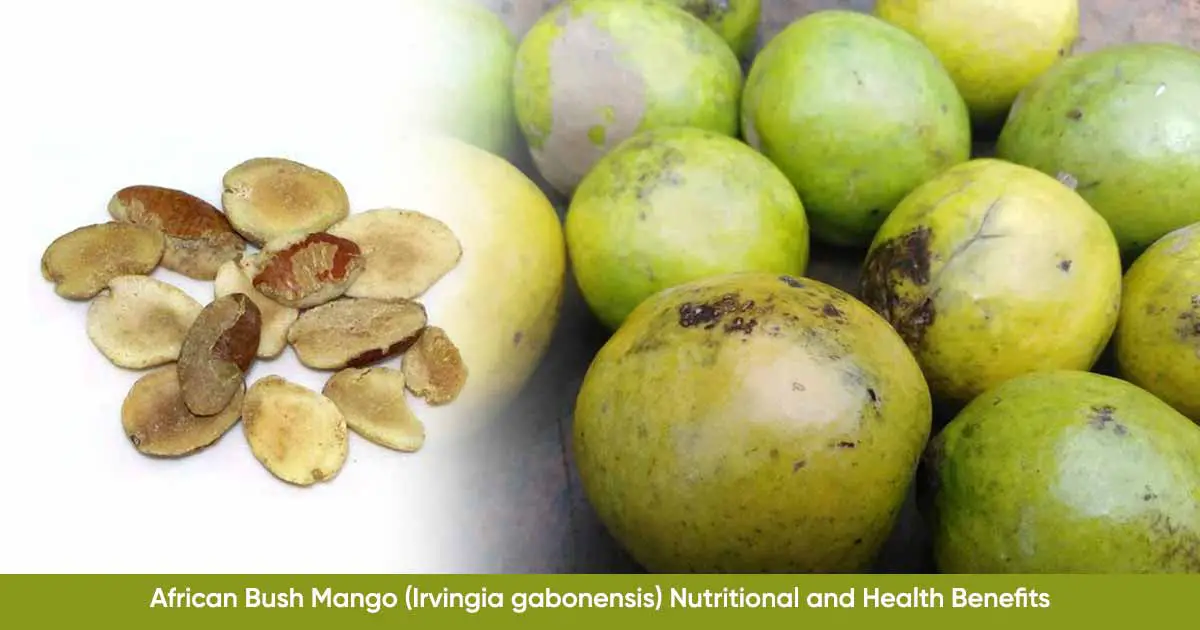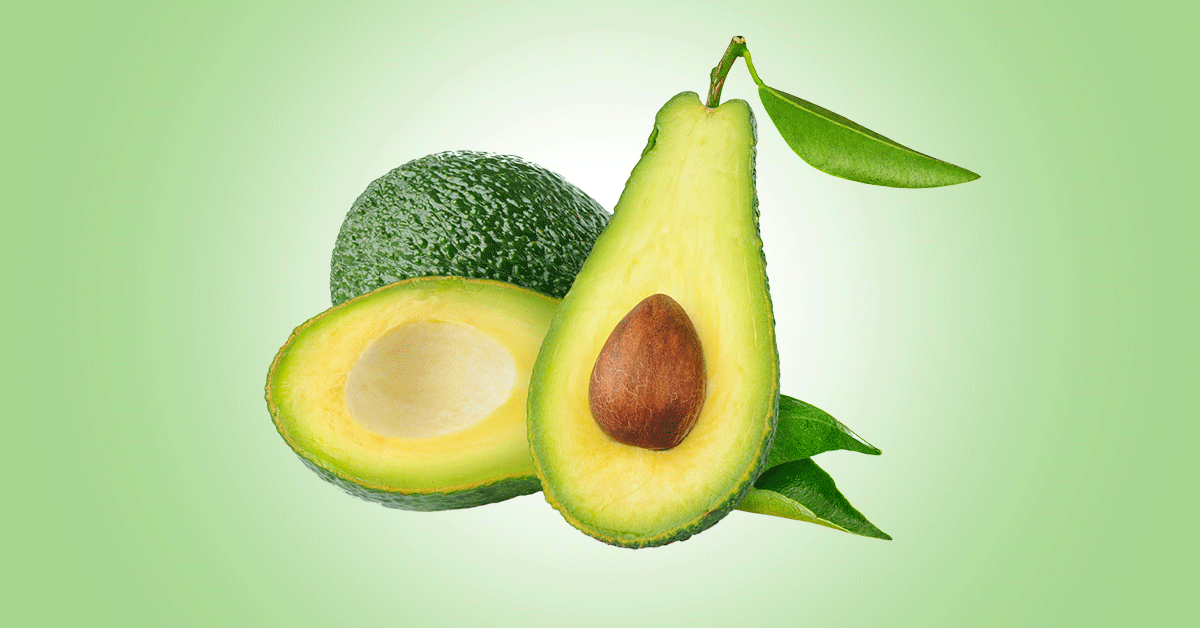Irvingia gabonensis, is a tropical plant belonging to the Irvingiaceae family. It is also called Bush mango, dika nut, dika nut tree, African mango, rainy season bush mango, sweet bush mango, wild mango (English), ‘manguier sauvage’, ‘chocolatier’, Ogbono (Igbo), Oro, Oyin (Yoruba), Ogwe, Ohere (Edo). Though the fruit is similar to the mango fruit (Mangifera indica), they are not related to each other, as mango fruit belongs to a different family (Anacardiaceae).
The fruit of African bush mango is a broad, green-colored, and sweet-smelling, ellipsoid drupe. It has a thin epicarp, and an edible fleshy orange juicy mesocarp (pulp) when ripe. The nut is hard, stony, and encloses a soft, oil rich, dicotyledonous kernel wrapped inside a brown seed-coat. The fruit is produced in July to August. This kernel, also called the seed, is an edible portion, just as the fleshy mesocarp.
Bush mango is a tall tree native to tropical West-Central African countries such as Nigeria, Cameroon, Ghana, Congo, Gabon, Senegal among others. It grows well in dense evergreen rain forests, and near riverbanks.
There are two species of bush mangoes, the ‘eating type’ and the ‘cooking type’. Though they are both green-yellow in color, the ‘eating type’ species of Irvingia gabonensis is fibrous, has a yellow to orange color, and a sweet-tasting mesocarp. The ‘cooking type’ which is the Irvingia wombolu species, has a bitter-tasting mesocarp, and therefore is not edible. But the seeds of both species are edible.
In traditional medicine, the bark is boiled in water and used to treat diarrhea, toothache, skin conditions, yellow fever, and as poison antidote, while powdered bark is applied topically to decrease pain, wounds, or sores. It has both antibiotic, anti-inflammatory, and analgesic properties. The fruit kernel is edible and is eaten to manage obesity and diabetes. Hot water infusion of the leaf is used to treat fever, intestinal worm.
Mashed kernels from bush mango are used to make “bread”, “butter” (similar to cocoa butter), and chocolate. The fruit is consumed fresh, or dried, and for making juices, jellies, smoothies, jams, wines. It is also utilized as a colorant, or flavoring agent in wine or juice making. The seed can be pressed for margarine, or vegetable oil. The ground seed is used to prepare “ogbono” soup, stew, chocolate, and dika bread.
The fresh fruit has a short shelf life, and can succumb to microbial attack.
An oral preparation of Irvingia gabonensis supplement is now used for weight management, lowering of glucose, total, and LDL cholesterol levels in the body. It is available as a standardized or unstandardized dry powder extract.
Composition of African Bush Mango (Irvingia gabonensis)
The mesocarp of African bush mango contains a high quantity of vitamin C, and other phytochemicals. Irvingia gabonensis fruit kernel is rich in oil (63%–69% crude fat) mostly myristic and lauric acids. The seed contains ellagic acid and its derivatives.
Nutritional Content
The pulp of bush mango has a moisture content between 78.8% to 90.5%, 0.8–1.8% of ash, 0.2–1.1% of fats, 0.4% fiber, 15.7–17.8% carbohydrates, 0.9–1.1% proteins. About 10% of the composition is soluble solids. The mesocarp of bush mango contains more vitamin C (51–76 mg/100 g) than sweet orange, and mango.
It contains high quantity of potassium (1114 mg/100 g), calcium (118 mg/100g), low sodium (2 mg/100 g).
The seed of bush mango has high energy (595–729 kcal), fat (10–71%), carbohydrates (3–52%) and protein (7–22%), and low fat.
Irvingia gabonensis seed kernel oil is a good source of edible fat (62%) comparable to walnut, coconut, watermelon seed, sunflower). It is a rich source of myristic acid, and lauric acid. There are unsaturated fatty acids (linoleic, linolenic, oleic acids) and saturated fatty acids (stearic acid, capric acid, lauric acid, arachidic acid, palmitic acid, myristic acids). Due to high levels of saturated fatty acids, and triaglycerides, it has high solid fats at room temperature.
Composition of Irvingia gabonensis vs Irvingia wombolu
Both Irvingia gabonensis and Irvingia wombolu contain varying levels of minerals such as magnesium, calcium, iron, copper, sodium, and zinc depending on the planting location soil types and other environmental conditions.
Bioactive Compounds
Irvingia gabonensis seeds contain tannins, saponins, terpenoids, flavonoids, phenols, alkaloids, sterols, glycosides, and anthraquinones.
Irvingia gabonensis also contain antioxidant compounds such as lupeol, ellagic acid and ellagic acid derivates (di-O-methyl ellagic acid, tri-O-methyl ellagic acid, monomethyl-ellagic acid, di-O-methyl ellagic acid hexoside, methyl ellagic acid-O- deoxyhexose, di-O-methyl ellagic acid-O-pentoside, di-O- methyl-ellagic acid deoxyhexoside and methyl-ellagic acid-O-rhamnosyl-rhamnoside).
There are also ellagitannins (di-HHDP-hexose and unknown ellagitannins) and flavonoids (kaempferol 3-O-glucoside, quercetin 3-O-rhamnoside, rhamnetin/iso- rhamnetin with one hexose group and one rhamnosyl-rhamnose and O-methylated flavon) in minor qauntities (Sun and Chen 2012).
There are other compounds such as phosphatidylcholine, hosphatidylinositol, phosphatidylethanolamine, phytosterols (4-desmethylsterols, b-sitosterol, chlolesterol, campesterol, clerosterol, stigmasterol, sitostanol, γ-sitosterol), phytol, neophytadiene, stigmasterol, vitamin E, hexadecanoic acid and its ethyl ester, phytyl palmitate, and squalene.
There are also tocopherols (b-tocopherol, a- and c-tocopherol)
Health Benefits of African Bush Mango (Irvingia gabonensis)
Antioxidant property:
Irvingia gabonensis contains polyphenols, and flavonoid compounds (lupeol, methyl gallate, ellagic acid, and other ellagic acid derivatives). These compounds are free-radicals scavengers (tested using methods such as DPPH radical, ferric reducing antioxidant power (FRAP), and hydroxyl radical scavenging activity).
Type-2 Diabetes management:
The soluble fiber of the seed of Irvingia gabonensis are bulk laxatives, which reduce blood sugar level after meal.
African mango (Irvingia gabonensis) seed extract contains terminalin, a compound that exhibits antidiabetic effect through inhibition of catalytic activity of PTPN1, PTPN9, PTPN11, and PTPRS in vitro. This cause a significant increase in glucose uptake in differentiated C2C12 muscle cells (Sun-Young Yoon et al., 2022).
Also, the seed extract of Irvingia gabonensis reduced the lipid profiles (triacylglycerol, total cholesterol and low-density lipoprotein level), and increased the high density lipoprotein (HDL) in alloxan-induced diabetic rats (Victor Eshu Okpashi et al., 2017)
Weight and Body Lipid management:
Fiber may also reduce the total blood cholesterol, LDL cholesterol, and triglycerides and raise HDL cholesterol.
Irvingia gabonensis seeds treatment led to reduction in mean body weight, total cholesterol, LDL-cholesterol, triglycerides, and an increase of HDL-cholesterol. There was also reduction in the systolic blood pressure (Judith L Ngondi et al., 2005)
Sickle cell treatment:
Irvingia gabonensis is reported to contain anti-sickling compounds that could help in managing sickle cell anemia, a blood disorder that results in abnormal, rigid, sickle shaped red blood cells (Amujoyegbe et al. 2016).
Hepatoprotective effect:
The juice extract of Irvingia gabonensis exhibit both renal and hepato-protective effects on sodium fluoride-induced toxicity in male Wistar albino rats. The etract reduced the serum aspartate aminotransferase (AST), alanine aminotransferase (ALT), creatinine and Cl- concentrations, and increased serum Ca2+ and Mg2+ ion levels (Adamma A Emejulu et al., 2016)
Cardioprotective property:
Seeds of Irvingia gabonensis exhibit cardioprotective property in doxorubicin (DOX)-mediated cardiotoxicity in Wistar rats. The extract reduced the serum cardiac enzyme markers (cardiac troponin I (cTI) and lactate dehydrogenase (LDH) elevated by doxorubicin injection. It also normalized the serum lipid profile, improved the antioxidant enzymes (catalase, superoxide dismutase, glutathione-S-transferase, and glutathione) (Adejuwon Adeneye et al., 2020).
Doxorubicin is an antibiotic anticancer medication that has adverse cardiotoxic side effects such as cardiomyopathy and heart failure, limiting its usage.
Gastrointestinal effect:
A methanol extract of African mango reduced gastric acid secretion and increased mucous secretion, in indomethacin-induced gastric ulceration in mice (Raji 2001).
Decreases uric acid content:
The extract of I. gabonensis kernels decreases the levels of urea, uric acid, creatine, total cholesterol, protein, alkaline acid, and prostatic phosphatase in adult male guinea pigs (Obianime and Uche, 2010)
Analgesic effect:
The analgesic effect was detected in the stem bark extract as it is reported to protect the mice from pain stimuli (Okolo et al. 1995)
Dosage
- For weight management, cholesterol, and glucose lowering: 150 milligrams of dry extract standardized to 7% albumin, to be taken two times per day before meal (Ross 2011; Ngondi et al. 2009; Oben et al. 2008a, b)
- As antioxidant: Dry powder, non-standardized Extracts (Dry extract, Tincture, Fluid extract, Decoction, Infusion). Must not exceed 3.15 grams of dried seed, per day (Ekpo et al. 2007; Ngondi et al. 2005).
Adverse Reaction
Irvingia gabonensis may cause symptoms of hypoglycaemia, including anxiety, dizziness, tremor, sweating, flatulence, sleep disturbance, nausea, or headache (Adamson et al. 1986; Ngondi et al. 2009; Oben et al. 2008a,b).
Bush mango seed can easily be infested with fungi and aflatoxins, so care must be taken in selection of seeds for cooking.
References
- https://forestcenter.iita.org/index.php/2019/07/23/irvingia-gabonensis/
- https://www.utep.edu/herbal-safety/herbal-facts/herbal%20facts%20sheet/african-mango.html
- https://www.scribd.com/document/661405072/mono-african-wild-mango-irvingia-gabonensis-english#
- https://pharmacologyonline.silae.it/files/archives/2019/vol1/PhOL_2019_1_A033_Ekpe.pdf
- https://www.longdom.org/open-access/renal-and-hepatoprotective-effects-of-irvingia-gabonensis-juice-on-sodiumfluorideinduced-toxicity-in-wistar-rats-50866.html
- https://pubmed.ncbi.nlm.nih.gov/35204821/
- https://www.ncbi.nlm.nih.gov/pmc/articles/PMC1168905/
- https://www.itmedicalteam.pl/articles/assessment-of-lipid-profile-indices-of-alloxaninduced-diabetic-rats-using-irvingia-gabonensis-seeds-extracts-108592.html
- http://www.giuseppezeppa.com/files/570.pdf
- https://www.researchgate.net/publication/334137145_Chemical_composition_proximate_and_phytochemical_analysis_of_Irvingia_gabonensis_and_Irvingia_wombolu_peels_seed_coat_leaves_and_seeds












